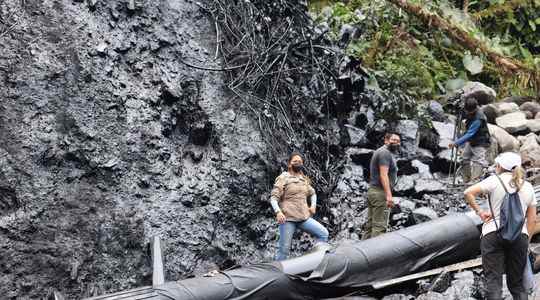The Amazon is once again in danger. Three years after the terrible fires that destroyed 906,001 hectares of forest, it is this time an oil leak that threatens the lungs of the planet and its waterways. A crude oil pipeline in the Ecuadorian zone of the forest was damaged by heavy rains which caused landslides and rockfalls at the end of the week.
The incident took place on Friday at the border between the provinces of Napo and Sucumbios, on this 485-kilometer pipeline, which crosses four provinces, and is operated by the private company OCP (Oleoducto de Crudos Pesados). Impressive images posted on Twitter by the Confederation of Indigenous Nationalities of Ecuador (CONAIE), a rights group, show the speed at which oil is leaking from the pipeline.
To date, neither the government nor the OCP have indicated the quantity of oil spilled into the environment, but the authorities are trying to contain the oil leak deemed to be “large in scale”. The company said in a statement that it had stopped pumping oil since Saturday.
OCP Ecuador said it had “immediately initiated the cleaning, environmental remediation as well as the repair of the pipeline in the Piedra Fina sector and implemented all necessary actions to avoid, reduce, mitigate and repair any impact linked to the rupture of the OCP pipeline caused by the landslide of January 28, 2022.” The company also said it had contained the spilled oil so that it “cannot contaminate bodies of water” and had stopped pumping crude oil until “the conditions are met. “. But the damage to this natural space is already there.
A polluted river and natural area
“We understood that there had been a large spill, acknowledged in a video broadcast on Saturday, an official from the ministry of Juan Pablo Fajardo, who came to see the damage at the site of the accident. We consider that there has been damage to water sources and that there has also been damage to third parties”.
The oil spilling from the damaged pipeline has indeed affected a protected natural area and a river that supplies water to several villages in this region of northeastern Ecuador. “The affected area is located in the Cayambe-Coca National Park and, according to the zoning, the oil spill took place in the protection zone,” the Ministry of the Environment said in a statement. Located about a hundred kilometers northeast of the capital Quito, this park is characterized by the omnipresence of water: falls, cascades, springs, lagoons, moors impregnated with humidity and shrouded in fog… all of this under incessant rain.
Settlers, indigenous peoples and environmental activists in the Amazon have also warned of traces of oil contamination arriving on the banks of the mighty Coca River, reports the EFE press agency.
About 21,000 m2 of the Cayambe-Coca reserve were affected by the oil leak. The crude also flowed into the Coca, a major river in the Amazon that flows into a river, the Napo, the ministry added. This river and river provide water to many communities, including indigenous peoples, and are at risk of contamination.
The private company OCP (Oleoducto de Crudos Pesados), which manages the pipeline, admitted that “small traces (of oil) have reached the waterways”. She said she had “started to provide drinking water” to several communities in the affected area, such as Toyuca, Sardinas and Guayusa, and promised food aid and medical care for the next few hours.
Home to a hundred mammal species
Covering an area of more than 4000 km2, the Cayambe-Coca National Park straddles four provinces, in an area of mountains and humid forests in the Amazon basin, between 600 and 5790 meters above sea level. About a hundred species of mammals are listed there (tapirs, cougars, bears, condors, etc.) and nearly 400 species of birds, likely to suffer from water contamination.
“We demand to know how many barrels have been dumped and what the process will be for delivering water and food to the communities,” the Confederation of Indigenous Nationalities of the Ecuadorian Amazon (Confeniae), the country’s main indigenous organization, said on Twitter. .It is clear that the water in the river cannot be used or consumed.” No independent damage assessment has been conducted at this time.
In Ecuador, about “two oil spills a week”
“This latest spill shows once again that Ecuador’s oil infrastructure is built to spill,” Kevin Koenig, director of energy and climate for environmental group Amazon Watch, said in a statement. NBC News. Despite promises to use state-of-the-art technologies and alleged commitments to environmental responsibility, Ecuador averages two oil spills a week. Government plans to double production and expand extraction deeper into the Amazon will only worsen the situation.”
“This is the exact reason why we oppose oil extraction,” added Andres Tapia of the Confederation of Indigenous Nationalities of the Ecuadorian Amazon, CONAIE’s parent organization. “Spills have become part of our daily lives, and we will live with this contamination for decades. The oil industry has brought us nothing but death and destruction. (…) We call on the government to end the expansion plans oil and properly clean up this oil spill and all the others that continue to contaminate our territories and violate our rights.”
